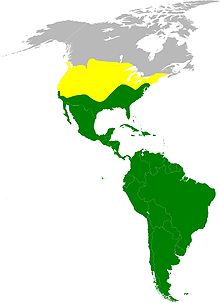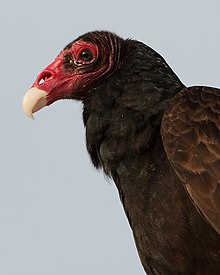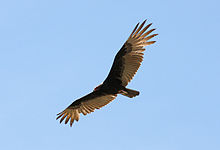Turkey vulture
| Turkey vulture | ||||||||||
|---|---|---|---|---|---|---|---|---|---|---|

Turkey vulture ( Cathartes aura ) |
||||||||||
| Systematics | ||||||||||
|
||||||||||
| Scientific name | ||||||||||
| Cathartes aura | ||||||||||
| ( Linnaeus , 1758) |
The turkey vulture ( Cathartes aura ) is a species from the New World vulture family . Characteristic of this almost completely black-feathered vulture are the long, broad wings, the long rounded tail, the hand wings, which are widely spread in flight, and the small, unfledged red head. It has the largest range of all types of the family. There are four subspecies, C. a. aura , C. a. iota , C. a. ruficollis and C. a. septentrionalis . The species is not considered endangered and is relatively numerous.
features
The turkey vulture reaches a height of 63.5 to 76 centimeters and weighs around 850 to 2000 grams. The wing length is 46 to 55 centimeters and the wingspan 1.80 to 2 meters. The tail is 22 to 29 inches long. His figure is slim. Males reach the same size as the females. The plumage is brown-black, shiny on the back. The wing feathers have gray-brown edges. The head is small, bare and red, the scalp is wrinkled. The beak is ivory in color. In the flight image from below, the bird is black except for the gray tail and the silvery hand wings. C. a. ruficollis is darker, has a yellowish neck and vertex, and the edges of the wing feathers are less pronounced. At C. a. iota , the head is bright red and the edges of the wing feathers are distinctly gray. Turkey vultures, like all New World vultures, do not have a septum.
Fledglings have a black beak and head. They have brown downy feathers on the nape and on the head. The head only turns red when it is one year old.
distribution
The turkey vulture lives in South , Central and North America and occurs from Tierra del Fuego and the Falkland Islands to a little north of the southern border of Canada . C. a. aura occurs in Central America, south to Costa Rica , on the Greater Antilles and in western North America. C. a. septentrionalis lives in North America. Both subspecies leave their northern range in winter and migrate through Central America to northern South America, possibly to Paraguay .
From the two South American subspecies, C. a. jota from southern Ecuador on the Pacific coast. He also lives in the Andes , Patagonia and Falkland Islands. C. a. ruficollis lives in the lowlands of the rest of South America, on Trinidad and in Panama and the south of Costa Rica. They occur in open terrain as well as in forests and in deserts. In mountains they go up to heights of 4300 meters.
nutrition
Turkey vultures look for carcasses individually or in small groups, gliding or rocking, with V-shaped wings. They kill fewer small animals than black vultures and are more dependent on carrion . They track the carrion with their well-developed sense of smell. Carcasses that are several days old are ignored, possibly to avoid ingestion of cadaveric poisons . They are often the first vultures on a fresh carcass, but are dominated by black vultures and great yellow-headed vultures and retreat when they eat. They later eat the remains that they have left behind.
In areas populated by humans, they often eat dead animals on the streets. This food source may have allowed the birds to expand their range north.
Reproduction
The reproductive biology of North American turkey vultures has been well studied, but little has been observed in tropical regions. The eggs are laid in Florida in March, in the rest of North America from May to June, in Cuba from December to March and in Panama from February to April. A nest is not built, but the two eggs are placed directly on the ground in caves, on cliff ledges or between rocks and then incubated for 38 to 41 days. The young, which are initially white, leave the nest after 70 to 80 days.
Turkey vulture and people
In Tierra del Fuego, the turkey vultures, which are common there, were hunted intensively for a long time, as they were said to kill lambs in particular. In 1917, four pence were still paid on these islands for each turkey vulture bill delivered. According to the Wild Animals & Birds Protection Ordinance of 1964 , the turkey vulture in the Falkland Islands is still classified as a pest that can be hunted throughout the year. Attitudes towards this species of vulture are gradually changing, however, and the intensity with which this species of vulture has been hunted has diminished. Turkey vultures feed largely on the sheep in the Falkland Islands, which are killed there annually towards the end of summer.
The animals' good sense of smell makes them interesting as sniffer birds for police purposes. In July 2010, the Lower Saxony State Criminal Police Office began training turkey vultures bred in Carinthia on a test basis to search for corpses .
supporting documents
literature
- Ferguson-Lees & Christie: The world's birds of prey . German by Volker and Jochen Dierschke. Franckh-Kosmos, Stuttgart 2009, ISBN 978-3-440-11509-1 .
- Josep del Hoyo et al .: Handbook of the Birds of the World. Volume 2: New World Vultures to Guinea Fowl. Lynx Edicions, Barcelona 1994, ISBN 84-87334-15-6 .
- Robin and Anne Woods: Atlas of Breeding Birds of the Falkland Islands . Anthony Nelson, Shorpshire 1997, ISBN 0-904614-60-3 .
Web links
- The Turkey Vulture Society
- The USGS page on Turkey Vultures
- Cathartes aura in the endangered Red List species the IUCN 2008. Posted by: BirdLife International, 2008. Accessed January 31 of 2009.
- Videos, photos and sound recordings of Cathartes aura in the Internet Bird Collection
Individual evidence
- ↑ Hadoram Shirihai: A Complete Guide to Antarctic Wildlife - The Birds and Marine Mammals of the Antarctic Continent and Southern Ocean . Alula Press, Degerby 2002, ISBN 951-98947-0-5 , p. 249.
- ↑ Wood, p. 100 and p. 101
- ↑ German police use turkey vultures from Carinthia. In: derStandard.at. July 14, 2010, accessed December 9, 2017 .
- ↑ http://www.ftd.de/wissen/mensch/:spuernasen-am-himmel-polizei-testet-geier-fuer-leichensuche/50144415.html ( Memento from July 16, 2010 in the Internet Archive )




